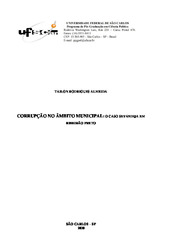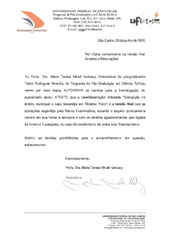| dc.contributor.author | Almeida, Tailon Rodrigues | |
| dc.date.accessioned | 2020-06-09T16:03:53Z | |
| dc.date.available | 2020-06-09T16:03:53Z | |
| dc.date.issued | 2020-03-02 | |
| dc.identifier.citation | ALMEIDA, Tailon Rodrigues. Corrupção no âmbito municipal: o caso Sevandija em Ribeirão Preto. 2020. Dissertação (Mestrado em Ciência Política) – Universidade Federal de São Carlos, São Carlos, 2020. Disponível em: https://repositorio.ufscar.br/handle/ufscar/12892. | * |
| dc.identifier.uri | https://repositorio.ufscar.br/handle/ufscar/12892 | |
| dc.description.abstract | This research addresses the phenomenon of political corruption at the municipal level, and its scope of work consists in conducting a case study having as its object of analysis the corruption scandal entitled Sevandija, which occurred in Ribeirão Preto, in the State of São Paulo, Brazil, during the second administration of former Mayor Dárcy Vera (PSD), between 2013 and 2016. We maintain that the institutions have strong relevance in the study of the proposed theme and we seek to combine the theoretical debate about Local Power with the institutional study of corruption. The general objective that guides our research is to analyze the institutional conditions of the municipal administration that allowed the practice of corruption. In this sense, we fundamentally seek to answer the following question: What are the institutional conditions that made possible the practice of corruption in Ribeirão Preto? The specific objectives of this research are: (1) to map the institutional circuits where the illicit practices occurred in Ribeirão Preto and; (2) to analyze the institutional mechanisms that made it possible to halt the actions of the assembled CPIs to investigate signs of irregularities in the municipality's budget execution. We use a qualitative methodology based on the case study focusing on historical neoinstitutionalism combined with semi-structured interviews with prosecutor Leonardo Leonel Romanelli, who coordinated the investigations by GAECO, and councilor Marcos André Papa (REDE), who chaired the CPI of Daerp. From the listed methodology, and in order to achieve the proposed objectives and answer the research question, we will analyze the following material: semi-structured interviews; minutes of legislative sessions at which CPIs were voted; investigation reports and case files prepared by the Public Prosecution Service in conjunction with GAECO; Internal Regulations of the Ribeirão Preto City Council; the Organic Law of the Municipality. | eng |
| dc.description.sponsorship | Coordenação de Aperfeiçoamento de Pessoal de Nível Superior (CAPES) | por |
| dc.language.iso | por | por |
| dc.publisher | Universidade Federal de São Carlos | por |
| dc.rights | Attribution-NonCommercial-NoDerivs 3.0 Brazil | * |
| dc.rights.uri | http://creativecommons.org/licenses/by-nc-nd/3.0/br/ | * |
| dc.subject | Corrupção | por |
| dc.subject | Poder local | por |
| dc.subject | Instituições políticas | por |
| dc.subject | Ribeirão Preto | por |
| dc.subject | Corruption | eng |
| dc.subject | Local-power | eng |
| dc.subject | Politics Institutions | eng |
| dc.title | Corrupção no âmbito municipal: o caso Sevandija em Ribeirão Preto | por |
| dc.title.alternative | Corruption at the municipal level: the Sevandija case in Ribeirão Preto | eng |
| dc.type | Dissertação | por |
| dc.contributor.advisor1 | Kerbauy, Maria Teresa Miceli | |
| dc.contributor.advisor1Lattes | http://lattes.cnpq.br/4762029784021248 | por |
| dc.description.resumo | A presente pesquisa aborda o fenômeno da corrupção política no nível municipal, e seu escopo de trabalho consiste em realizar um estudo de caso tendo como objeto de análise o escândalo de corrupção intitulado Sevandija, ocorrido no município de Ribeirão Preto, no Estado de São Paulo, durante a segunda gestão da ex-prefeita Dárcy Vera (PSD), entre os anos de 2013 e 2016. Sustentamos que as instituições possuem forte relevância no estudo da temática proposta e buscamos aliar o debate teórico sobre poder local com o estudo institucional da corrupção. O objetivo geral que guia nossa pesquisa consiste em analisar as condições institucionais da administração municipal que possibilitaram a prática da corrupção. Neste sentido, procuramos fundamentalmente responder à seguinte questão: Quais as condições institucionais que viabilizaram a prática da corrupção no município de Ribeirão Preto? Os objetivos específicos trabalhados nesta pesquisa consistem em: (1) mapear os circuitos institucionais por onde ocorreram as práticas ilícitas em Ribeirão Preto e; (2) analisar os mecanismos institucionais que possibilitaram a paralização das ações das CPIs montadas para investigar indícios de irregularidades na execução orçamentária do município. Utilizamos uma metodologia de base qualitativa fundamentada no estudo de caso com enfoque no neoinstitucionalismo histórico combinado com entrevistas semi-estruturadas com o promotor de Justiça Leonardo Leonel Romanelli, que coordenou as investigações pelo GAECO, e o vereador Marcos André Papa (REDE), que presidiu a CPI do Daerp. A partir da metodologia elencada, e no intuito de atingir os objetivos propostos e responder à pergunta de pesquisa, analisaremos o seguinte material: atas das sessões legislativas em que as CPIs foram votadas; entrevistas semi-estruturadas; relatórios de investigação elaborados pelo Ministério Público em conjunto com o GAECO; Regimento Interno da Câmara Municipal de Ribeirão Preto e; a Lei Orgânica do Município. | por |
| dc.publisher.initials | UFSCar | por |
| dc.publisher.program | Programa de Pós-Graduação em Ciência Política - PPGPol | por |
| dc.subject.cnpq | CIENCIAS HUMANAS::CIENCIA POLITICA::COMPORTAMENTO POLITICO | por |
| dc.subject.cnpq | CIENCIAS HUMANAS::CIENCIA POLITICA::ESTADO E GOVERNO | por |
| dc.subject.cnpq | CIENCIAS HUMANAS::CIENCIA POLITICA | por |
| dc.description.sponsorshipId | CAPES: Código de Financiamento 001 | por |
| dc.description.sponsorshipId | CAPES: 88882.426548/2019-01 | por |
| dc.publisher.address | Câmpus São Carlos | por |
| dc.contributor.authorlattes | http://lattes.cnpq.br/7257836742231052 | por |


